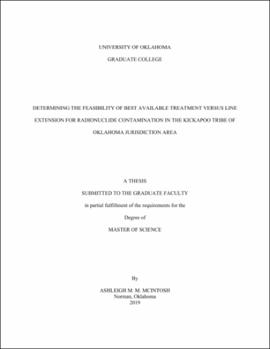| dc.contributor.advisor | Strevett, Keith | |
| dc.contributor.author | McIntosh, Ashleigh | |
| dc.date.accessioned | 2019-05-14T20:23:33Z | |
| dc.date.available | 2019-05-14T20:23:33Z | |
| dc.date.issued | 2019-05-10 | |
| dc.identifier.uri | https://hdl.handle.net/11244/319743 | |
| dc.description.abstract | This project aims to compare best available treatment (BAT) options to a line extension, therefore, presenting residents within the Kickapoo Tribe of Oklahoma (KTO) jurisdictional area with the most effective, in terms of cost and ease of use, option for obtaining potable water. This study also infers hot spots through sampling and geographic information system (GIS) modeling to gauge the extent of necessary treatment or line extension. Residents in this area are currently drawing water from wells with naturally occurring radionuclide contamination. A hydraulic model was completed as a means to design a line extension. Literature was surveyed to review the effectiveness of different BAT options for private well systems and aided the overall comparison to line extension. The BAT solution chosen includes three different sizes of Celpure® P300 diatomite based ceramic depth filter and a strong acid cation exchange unit with DIAION SK1B sodium based resin. The project compares the costs for residential upkeep and the costs of both installation and initial maintenance by Indian Health Service (IHS) for both solutions. These comparisons helped determine cost efficiency. A line extension is the most effective option of potable water for residents, the tribe, and IHS due to a need for longevity of treatment and issues that may arise from the cost of individual upkeep. This is significant because the cost of a BAT solution would far exceed the average income per home per year for residents in this area. Individual treatment systems also leave residents with hazardous wastes that they would be responsible for handling and disposing of properly. A line extension provides minimal cost and maintenance for the homeowner while ensuring that the residents are supplied with safe water. This information provides IHS and the KTO with a feasible recommendation of how to deliver potable water to the residents with naturally occurring radionuclide contamination. Through sampling and GIS modeling, this project also pinpoints areas of radionuclide contamination in the KTO jurisdictional area for further reference or studies. 49 of the 57 homes in the study area lie within an area at risk for contamination. Two homes are at risk for a higher degree of uranium contamination (45-60 µg/L) and may benefit from immediate chemical testing. | en_US |
| dc.language | en_US | en_US |
| dc.rights | Attribution-NonCommercial-NoDerivatives 4.0 International | * |
| dc.rights.uri | https://creativecommons.org/licenses/by-nc-nd/4.0/ | * |
| dc.subject | Water | en_US |
| dc.subject | Kickapoo Tribe of Oklahoma | en_US |
| dc.subject | Radionuclide Contamination | en_US |
| dc.subject | Indian Health Service | en_US |
| dc.title | Determining the Feasibility of Best Available Treatment Versus Line Extension for Radionuclide Contamination in the Kickapoo Tribe of Oklahoma Jurisdiction Area | en_US |
| dc.contributor.committeeMember | Sabatini, David | |
| dc.contributor.committeeMember | Kibbey, Tohren | |
| dc.date.manuscript | 2019-05 | |
| dc.thesis.degree | Master of Science | en_US |
| ou.group | Gallogly College of Engineering::School of Civil Engineering and Environmental Science | en_US |
| shareok.nativefileaccess | restricted | en_US |

